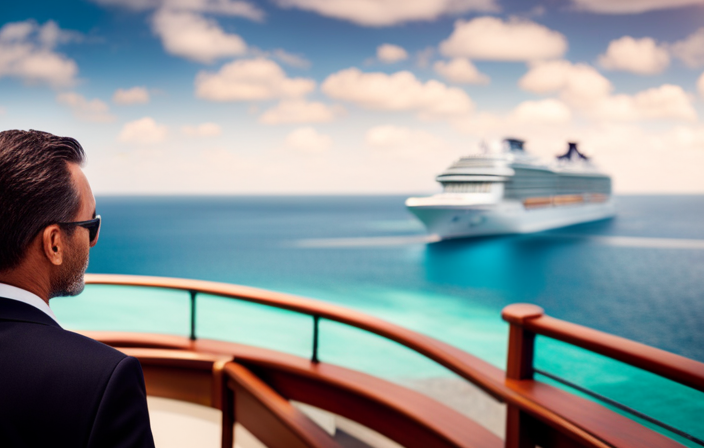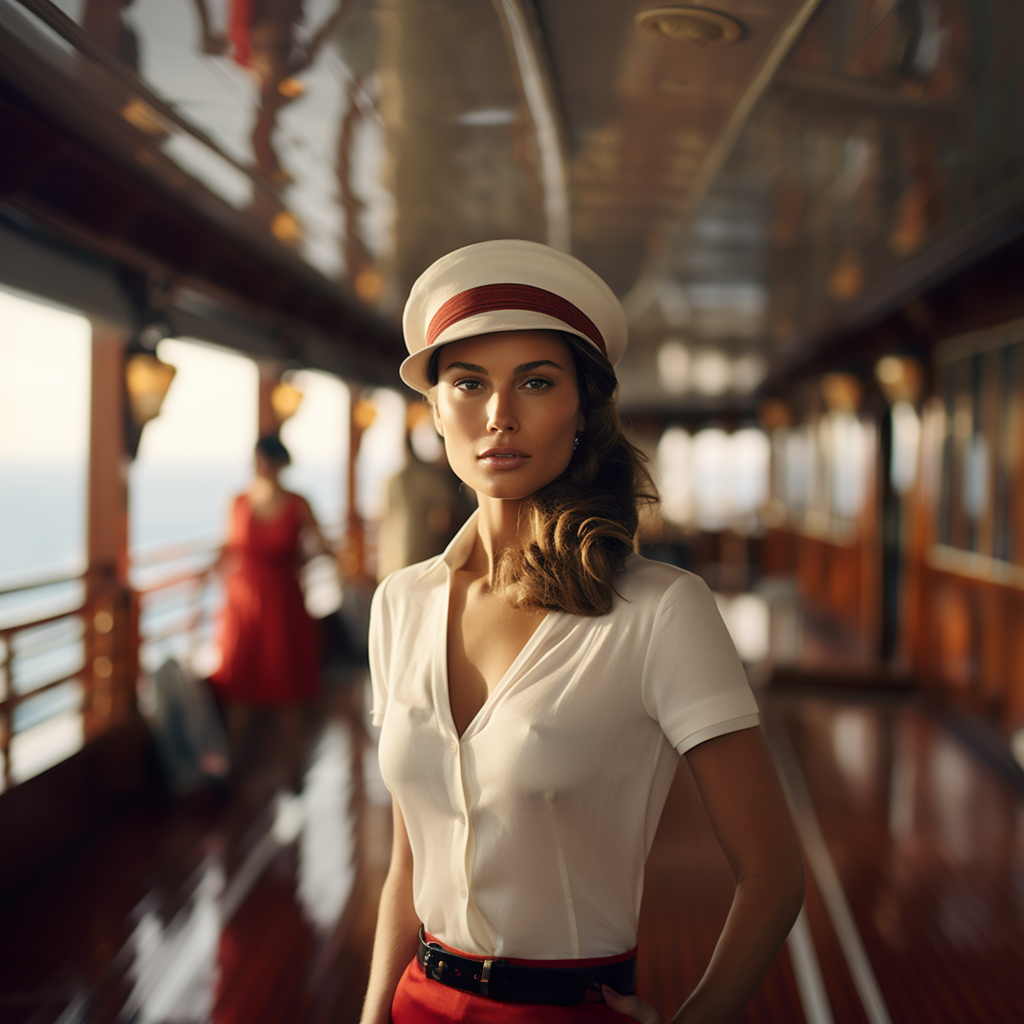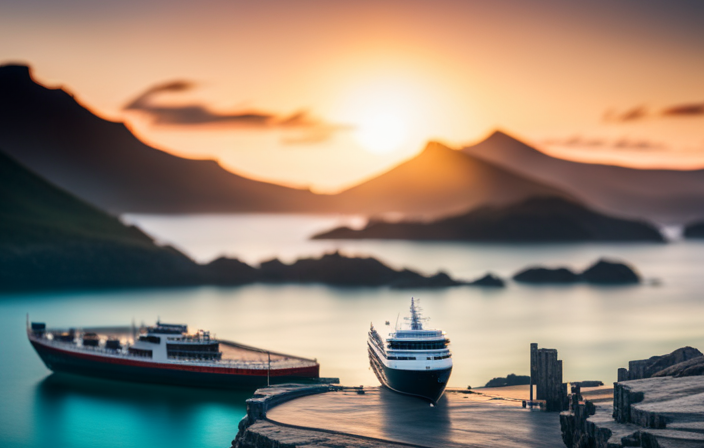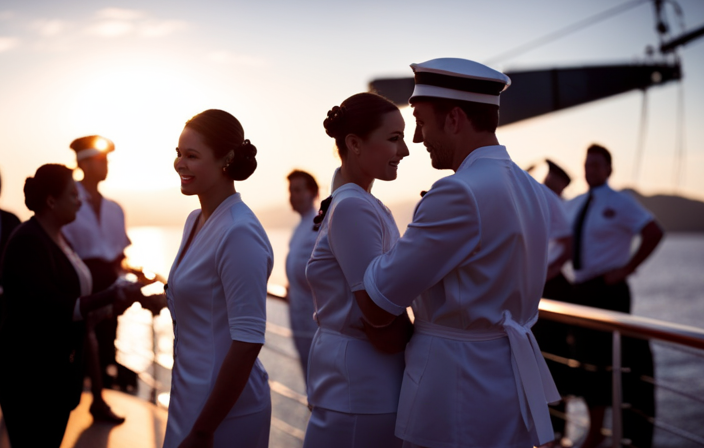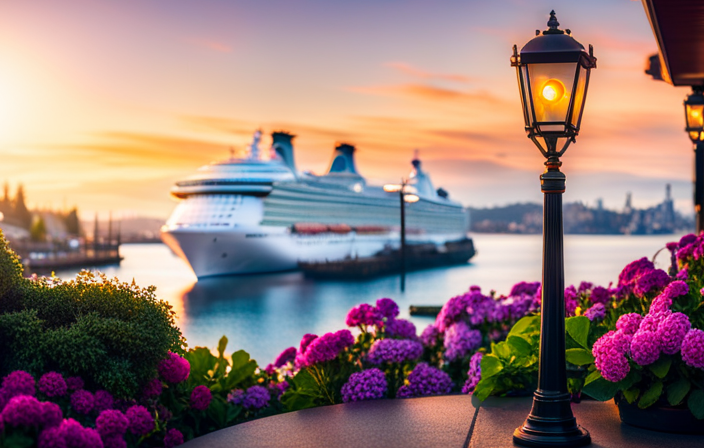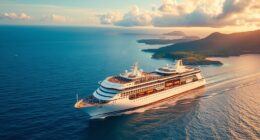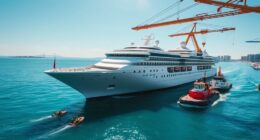Have you ever thought about the number of people that can fit on a typical cruise ship? Let me give you a visual. Picture yourself standing on the deck of a huge floating city, with shining white walls and towering smokestacks surrounding you. As the ship starts its journey, your view is filled with a throng of enthusiastic passengers, eagerly looking forward to their upcoming sea voyage. Witnessing such a spectacle is truly astonishing.
In this article, we will delve into the world of cruise ship passenger capacity. We will explore the growth of the cruise industry and the size range of these magnificent vessels. I will provide you with data-driven insights into the average passenger capacity and highlight some of the largest cruise ships in existence.
Additionally, we will examine factors that determine passenger capacity and discuss how it impacts the overall cruise experience. We’ll also take a glimpse into trends in cruise ship design and passenger capacity management.
So buckle up as we embark on this voyage to uncover just how many passengers can be accommodated on an average cruise ship!
Key Takeaways
- The average passenger capacity of a cruise ship is determined by its size, cabin types, and utilization strategies.
- Larger cruise ships have higher passenger capacity and can accommodate more passengers.
- Different cabin types impact the overall capacity of the ship.
- Utilization strategies, such as pull-down beds and optimized dining spaces, are used to maximize the passenger capacity of a ship.
The Growth of the Cruise Industry
Get ready to set sail and discover how the cruise industry has been growing!
Over the past few decades, the cruise industry has experienced remarkable growth rates. In fact, according to a report by Cruise Lines International Association (CLIA), the number of global cruise passengers has increased from 1.4 million in 1970 to a staggering 30 million in 2019. This exponential growth can be attributed to various factors such as increasing disposable income, improved affordability, and expanding fleet sizes.
The growth of the cruise industry has had a significant economic impact worldwide. It has created numerous job opportunities both on board and onshore, contributing to local economies. Furthermore, it has stimulated tourism in many regions, leading to increased revenue for hotels, restaurants, and other businesses.
Now that we’ve explored the growth of the cruise industry and its economic impact, let’s dive into another exciting aspect: the size range of cruise ships.
The Size Range of Cruise Ships
Sailing the ocean, these floating cities accommodate a diverse range of vacationers, from intimate boutique vessels to vast behemoths that rival small towns. Cruise ships come in various sizes, with size variations ranging from smaller ships carrying around 100 passengers to larger ones that can hold several thousand passengers.
The size of a cruise ship often determines the number and variety of passenger amenities available onboard. Smaller ships may offer a more intimate and personalized experience, while larger ships can provide a plethora of entertainment options such as multiple restaurants, theaters, swimming pools, and even shopping centers. These different size variations cater to the preferences and needs of different types of travelers.
Transitioning into the subsequent section about ‘the average passenger capacity,’ it is interesting to explore how these varying sizes impact the overall number of passengers they can accommodate without compromising comfort or safety.
The Average Passenger Capacity
Immerse yourself in the vibrant atmosphere of a floating city, where every corner is teeming with life and excitement. The average passenger capacity on a cruise ship can vary depending on its size and amenities. Here are three key factors that contribute to the average passenger demographics:
-
Ship Size: Larger cruise ships generally have a higher passenger capacity compared to smaller ones.
-
Cabin Types: The mix of cabin types, such as inside cabins, ocean view cabins, and suites, can also impact the overall passenger capacity.
-
Utilization Strategies: Cruise lines employ various strategies to maximize their passenger capacity, such as utilizing pull-down beds or sofa beds in cabins and optimizing dining spaces by offering multiple seating times.
By understanding these factors, cruise lines can cater to different traveler preferences while maximizing their vessel’s potential for accommodating passengers. Now let’s explore the world of the largest cruise ships without missing a beat.
The Largest Cruise Ships in the World
Little did we know, the behemoths of the sea have set sail, ready to dwarf our expectations and challenge the limits of maritime engineering. When it comes to luxury cruise ships, size definitely matters. The largest cruise ships in the world not only offer a lavish experience but also leave a significant environmental impact. Let’s take a look at some of these impressive vessels:
| Ship Name | Gross Tonnage | Passenger Capacity |
|---|---|---|
| Symphony of the Seas | 228,081 | 6,680 |
| Harmony of the Seas | 226,963 | 6,687 |
| Oasis of the Seas | 225,282 | 5,400 |
| Allure of the Seas | 225,282 | 5,400 |
| Quantum of the Seas | 168,666 | 4,180 |
These mammoth ships provide an unparalleled experience for their passengers but also raise concerns about their environmental impact. Now let’s explore how factors such as ship design and safety regulations determine passenger capacity.
Factors that Determine Passenger Capacity
One of the factors that determines how many people can be accommodated on a cruise ship is its gross tonnage. Gross tonnage refers to the total interior volume of the ship, including all passenger and crew areas. The larger the gross tonnage, the more space available for passengers, resulting in higher passenger capacity.
Additionally, other factors influencing passenger capacity include the number and size of cabins, public spaces such as restaurants and entertainment venues, as well as safety regulations regarding lifeboat capacity.
It’s important to note that passenger capacity directly impacts the cruise experience. A ship with a higher passenger capacity may offer a wider variety of amenities and activities onboard, but it may also lead to crowded areas during peak times. Considering these factors can help travelers choose a cruise ship that best suits their preferences for comfort and convenience.
As we delve into amenities and facilities on cruise ships…
Amenities and Facilities on Cruise Ships
Get ready to enjoy an array of amenities and facilities on your upcoming cruise. These include luxurious spas, state-of-the-art fitness centers, and even rock climbing walls that cater to adventurous individuals.
Did you know that some cruise ships have over 20 different dining options available onboard? Cruise ship dining is a culinary experience in itself. From fine dining restaurants serving gourmet cuisine to casual buffet-style eateries offering a wide variety of international dishes, there is something to suit every taste.
You can also indulge in entertainment options like Broadway-style shows, live music performances, and themed parties that will keep you entertained throughout your voyage. Whether you’re looking for relaxation or excitement, there’s something for everyone on a cruise ship.
As we move into the next section about the impact of passenger capacity on the cruise experience, let’s explore how these amenities and facilities are influenced by the number of passengers onboard.
The Impact of Passenger Capacity on the Cruise Experience
The impact of passenger capacity on the cruise experience can be significant. With a higher number of people onboard, the cruise experience can become more bustling and lively. However, it also has an impact on passenger satisfaction and demographics.
When there are more passengers on a cruise ship, it can lead to longer lines and crowded areas, which may affect the overall experience. Some individuals may find this overwhelming and prefer a more relaxed and spacious environment. On the other hand, some people enjoy the vibrant atmosphere and social interactions that come with a larger crowd.
Passenger demographics also play a role in determining the impact of passenger capacity. Different age groups and nationalities have varying preferences when it comes to space and privacy. For example, older passengers may prefer quieter areas and more personal space, while younger passengers might enjoy more social activities and larger gathering spaces.
Cruise lines take these factors into consideration when designing their ships to ensure they cater to a range of passenger needs. They strive to strike a balance between providing enough capacity to accommodate a significant number of guests while also creating spaces that allow for comfort and enjoyment.
Moving forward, it is interesting to explore the trends in cruise ship design and how they align with increasing passenger capacity. Cruise lines are constantly innovating and finding ways to enhance the cruise experience for passengers, whether it’s through the addition of new amenities or the creation of more intimate spaces within the larger ship.
Trends in Cruise Ship Design and Passenger Capacity
As we discussed in the previous subtopic, passenger capacity has a significant impact on the cruise experience. Now, let’s delve into the trends in cruise ship design and passenger capacity. With advancements in technology, cruise ships have undergone remarkable transformations to enhance the onboard experience for passengers. From state-of-the-art facilities to innovative entertainment options, cruise ship companies are constantly striving to provide a memorable journey. One notable trend is the incorporation of cutting-edge technology throughout the ship, including smart cabins and interactive touchscreens that allow passengers to control various aspects of their stay. Additionally, there have been significant innovations in onboard entertainment, such as virtual reality experiences and high-tech theaters. These developments not only attract more passengers but also ensure their satisfaction during the voyage. Speaking of which, managing a large number of passengers can present its own challenges…
[//]: # (Transition: Let’s now explore the challenges of managing a large number of passengers.)Challenges of Managing a Large Number of Passengers
Navigating through a bustling sea of excited vacationers, each with their own unique needs and desires, can pose challenges when managing crowds on a cruise ship. Safety measures are crucial to ensure smooth operations. Here are four key considerations when managing a large number of passengers:
-
Crowd control: Implementing effective crowd management strategies is essential. This helps prevent overcrowding and maintain order throughout the ship.
-
Safety protocols: Establishing rigorous safety protocols is important. This includes conducting emergency drills and regular maintenance checks. These measures help mitigate potential risks and ensure the well-being of all passengers.
-
Staff training: Well-trained staff members play a vital role in managing crowds. They provide clear directions, assistance, and exceptional customer service. Their presence helps maintain order and address any concerns that may arise.
-
Technology integration: Utilizing advanced technologies like facial recognition systems and AI-powered analytics can enhance crowd management. These technologies monitor passenger movements and enhance overall security.
Looking ahead to the future of cruise ship passenger capacity, new innovations will continue to shape how we seamlessly manage these challenges.
The Future of Cruise Ship Passenger Capacity
Managing a large number of passengers on a cruise ship is no easy task. From ensuring their safety to providing excellent customer service, it requires meticulous planning and efficient execution. However, as we look towards the future of cruise ship passenger capacity, advancements in technology and sustainability measures offer promising solutions.
Future technology holds great potential for enhancing the passenger experience while managing larger crowds. For example, virtual reality could be used to create immersive onboard experiences that alleviate overcrowding in common areas. Additionally, smart sensors and data analytics can help optimize crowd flow and improve overall efficiency.
In terms of sustainability measures, cruise lines are increasingly investing in eco-friendly practices to reduce their environmental impact. This includes implementing advanced waste management systems, using cleaner fuels, and exploring alternative energy sources like solar panels.
To further illustrate the possibilities that lie ahead, let’s take a look at the following table:
| Future Technology | Sustainability Measures |
|---|---|
| Virtual Reality | Advanced Waste Management |
| Smart Sensors | Cleaner Fuels |
| Data Analytics | Alternative Energy |
As we embrace these innovations and sustainable practices, the future of cruise ship passenger capacity looks bright. With careful planning and responsible management, we can continue to provide exceptional experiences for passengers while minimizing our ecological footprint.
Frequently Asked Questions
What is the average age of passengers on a cruise ship?
The average age of passengers on a cruise ship varies greatly, impacting the age distribution and activities onboard. Understanding the demographics is key to providing tailored experiences and amenities for all guests.
Are there any restrictions on the number of children allowed on a cruise ship?
There are child age restrictions on cruise ships, but each cruise line has its own policies. Child care services are usually available onboard to ensure a safe and enjoyable experience for families.
How are the cabins allocated to passengers on a cruise ship?
As the saying goes, "There’s a place for everyone." When it comes to cabin assignment on a cruise ship, passenger preferences are taken into consideration. Factors like location, size, and amenities play a role in ensuring a pleasant and comfortable journey.
Is there a limit to the number of crew members on a cruise ship?
Yes, there is a limit to the number of crew members on a cruise ship. Crew member qualifications vary based on their specific roles and responsibilities, which can include hospitality, entertainment, navigation, and safety.
How does the passenger capacity of a cruise ship affect the availability of onboard activities and entertainment options?
The passenger capacity of a cruise ship significantly impacts the availability of onboard activities and entertainment options. It determines the variety and size of venues, as well as the ability to cater to diverse passenger demographics and provide a range of dining options.
Conclusion
In conclusion, the average cruise ship carries around 2,500 passengers. This number may seem like a drop in the ocean compared to the largest ships that can accommodate over 6,000 passengers.
However, behind these figures lies a fascinating world of growth and innovation in the cruise industry. The increasing passenger capacity brings both challenges and opportunities for cruise lines to enhance the onboard experience.
As the industry continues to evolve, it is clear that the future holds even greater possibilities for cruise ship passenger capacity. So hop on board and set sail towards new horizons!
Meet Asra, a talented and adventurous writer who infuses her passion for exploration into every word she writes. Asra’s love for storytelling and her insatiable curiosity about the world make her an invaluable asset to the Voyager Info team.
From a young age, Asra was drawn to the power of words and their ability to transport readers to far-off lands and magical realms. Her fascination with travel and cultures from around the globe fueled her desire to become a travel writer, and she set out on a journey to turn her dreams into reality.

